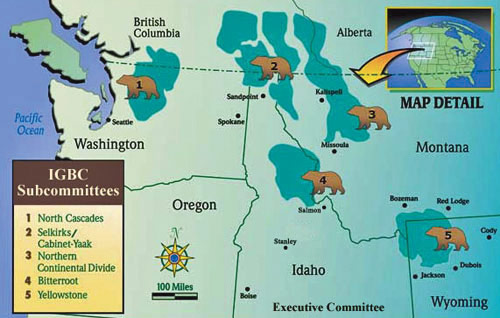Grizzly bears, the iconic species that once roamed the Western landscape before being threatened nearly to oblivion, have staged an historic comeback across the northern Rockies.
That much is not debatable. The question now is where do grizzlies go from here?
Wildlife officials are preparing to restart the process of removing special protections under the Endangered Species Act for bears near Yellowstone National Park. The move could occur as early as next month and lead the way for other delisting proposals, including one for Northwest Montana’s robust population.
The Yellowstone population is one of six that are defined in the lower 48 states. There are roughly 700 bears roaming around the 19,000-square-mile region centered on the national park spanning Montana, Idaho and Wyoming. It’s the second largest cluster of bears behind the Northern Continental Divide Ecosystem, which is home to more than 1,000 grizzlies in the vast region extending south from the Canadian border through the Flathead and Mission valleys to the Blackfoot River basin near Missoula and includes Glacier National Park.
The NCDE population, also considered recovered and healthy by the U.S. Fish and Wildlife Service, is a few steps behind Yellowstone in terms of the delisting process.
Last May, the USFWS released a draft management plan for potentially delisted grizzlies in Western Montana, laying out a conservation blueprint for wildlife managers if the threatened species loses its special protections.
The agency received more than 20,000 comments on the proposed conservation strategy, according to Gary Bertellotti, a region manager for Montana Fish, Wildlife and Parks in Great Falls, who gave a presentation last week on the NCDE ecosystem.
Bertellotti said the agency is categorizing the comments and preparing to publicly address any issues that were raised.
Grizzlies were deemed “threatened” in the lower 48 and granted protection under the ESA in 1975. Since then the species has rebounded and nearly doubled in size in many regions, leading wildlife officials to seek the removal of ESA protections while establishing a strategy for handling bear populations and their habitats under new management.
Last week the interagency group tasked with shepherding the recovery of America’s grizzlies unanimously supported lifting federal protections for the population in and around Yellowstone.
At its annual meeting in Missoula, the Interagency Grizzly Bear Committee, a collective of state, local, tribal and federal managers and biologists from across the U.S., formally endorsed a new report that determined the habitat and alternate food sources in the Yellowstone ecosystem are adequate for grizzlies. The report, based on a multi-year study conducted by the Interagency Grizzly Bear Study Team, addressed issues that were raised in federal court four years ago and reversed delisting.
Chris Servheen, a grizzly bear expert and recovery coordinator with the USFWS, told the committee that Yellowstone’s grizzlies are healthy and have successfully adapted to alternative food sources such as elk and bison to make up for declining pine nuts.
The overwhelming acceptance by the IGBC sends a signal to the USFWS that it can reinitiate the process of lifting federal protections for the Yellowstone grizzlies.
The USFWS will review the new report and is expected to decide in the next month whether to move forward with a proposed rule to delist that specific population. If so, the proposal would be published for comment in mid-2014, according to the IGBC.
 |
|
Map courtesy Interagency Grizzly Bear Committee |
Lawsuits halted the first attempt at delisting Yellowstone’s population in 2007 and the U.S. 9th District Circuit Court of Appeals reinstated the bears’ protected status. The court cited the increasing loss of a vital food source, white-bark pine, due to climate change as a significant danger to grizzlies.
Despite the latest findings, the IGBC study and potential delisting is already sparking opposition among environmental groups claiming the move is premature.
“The grizzly bear is arguably the most beautiful and powerful symbol of our wild heritage,” Bonnie Rice, the Montana representative for the Sierra Club, said in a statement following the IGBC’s decision. “Grizzlies are integral to the Yellowstone region, both to our natural systems and to our economy. Thanks to the Endangered Species Act, they are making a remarkable comeback, but are still vulnerable.”
Rice questioned the study team’s latest report, disputing the agency’s population estimates and raising concerns about the long-term population trend, impacts of the loss of key grizzly food sources and the isolation of Yellowstone bears from other grizzly populations.
“It is vital that grizzly bears make a full recovery so they don’t slide back towards extinction,” Rice stated.
Last week new information also surfaced about the bear population in the Cabinet Mountains and Yaak River drainage of Northwest Montana. Research leader Kate Kendall presented new findings of a “hair of the bear” study that gathered samples from animals in the mountains above Eureka, Libby, Trout Creek, Yaak and Troy. Kendall said the research identified 38 grizzlies by their DNA. Another four collared bears are also known to be in the area whose DNA didn’t appear in the samples.
The research team used roughly 800 scent-baited “hair corrals” with rings of barbed wire that collected hair as the animals approached the scent of bait.
The research team collected samples in roughly 1,200 places in a 3,750-square-mile area, according to Kendall.